Feeling the heat
This week: Ambient and Actual temperature; Humidity and dewpoint; Dirty, dusty work; Developing plans; More fire remains; Feeling the heat; Looking back;

That’s it then!
Mid-Summer’s Day passed on Monday, so it is all uphill now until mid-winter in just six months time.

We had thin cloud cover from dawn to dusk on June 21st. So no inspiring photos this week of the rising or setting sun. Instead, just the sultry heat and high humidity of a Mediterranean dawn.
I recorded the hottest ever June temperature on Tuesday. This was of 36.2ºC (97.2ºF), the warmest June day since I commissioned my weather station here in Dol.

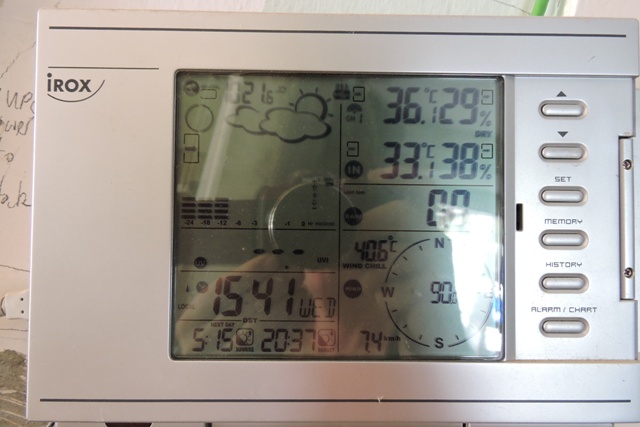
With high barometric pressure stationary over the central Mediterranean region and a heat dome over central Europe, there have been severe weather warnings in force for most countries in the region.

The European Severe Weather Centre pushes out warning for all kinds of severe weather, throughout the year and this week the centre have been warning of temperatures reaching 36ºC or more.

At this temperature prolonged exposure to the heat is a hazard to health, especially for those with underlying health conditions.
It has already been +27ºC at 06:30 several mornings this week.
So as the temperature had edged past 33ºC, a temperature when it is too hot for sensible people to be outside, I decided to play around with some of the data that I record.
Only a fraction of the data points that my station records every five minutes, do I actually use.
As a part of a Citizen Science project, all the figures are all uploaded in real time to a number of national meteorological agencies like NASA. Then the various agencies super computers number crunch everyone’s data, to produce actual charts and forecasts.
The recording, transfer and publication of daily maximum and minimum figures is automatic, but to get addition deep data I have to draw it out manually.
So for this hot spell I have been extracting the station’s readings at 01:00, 07:00, 13:00 and 19:00 daily and then doing some calculations.
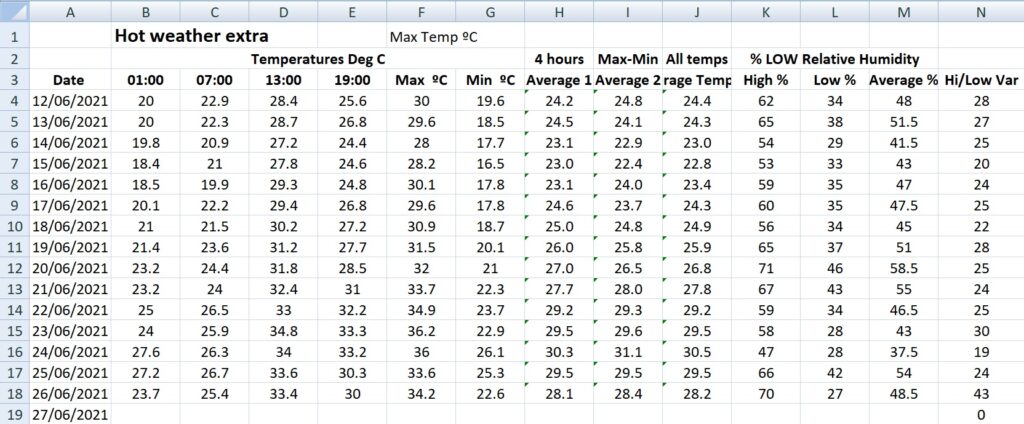
Usually I just use the daily maximum and minimum figures to produce the average. The four times daily is the WMO “Gold standard” way of obtaining a daily average.
With all the data for the last ten days, what I have found is that there is only 0.2 of a degree difference between an average of the daily maximum and minimum temperatures, and an average of the maximum and minimum and the 4 six-hourly readings.
Occasionally there is less than a 0.3 of a degree difference. To a Climatologist, 0.2 of a degree is significant. To me, it is merely interesting to be accurate.
I will keep using my simple average calculation, of the [maximum temperature] + [the minimum temperature] divided by 2.
Ambient & Actual temperature
Have you ever noticed when you are listening to a weather forecaster on the TV or radio, that they will say that it will feel hotter or colder than the actual temperature shown on a thermometer?
That is because it is true. The air moisture content (relative humidity) can make an environment feel warmer than it is and wind chill can make it feel colder.
This is due to the fact that warm air can hold more water vapour than cold air, which reduces the relative humidity.
There is a complex relationship between the actual temperature, the relative humidity and the dew point.
Humans and mammals need to feel comfortable in their environment. This is called “Thermal comfort“, a scientific discipline mainly related to building design.
As a result of evolution and genetics, mammals are highly sensitive to temperature and air moisture fluctuations. Therefore, the actual temperature will always be lower than the ambient temperature felt, unless there is little to no moisture content in the air.
Some national meteorological agencies use the term “Heat Index” to describe in simple terms how hot it will feel.
This index was only developed a little over 40 years ago.
It is a standard way of looking at the relationship between actual temperature and relative humidity, and then showing the perceived ambient temperature you feel and the level of heat threat.
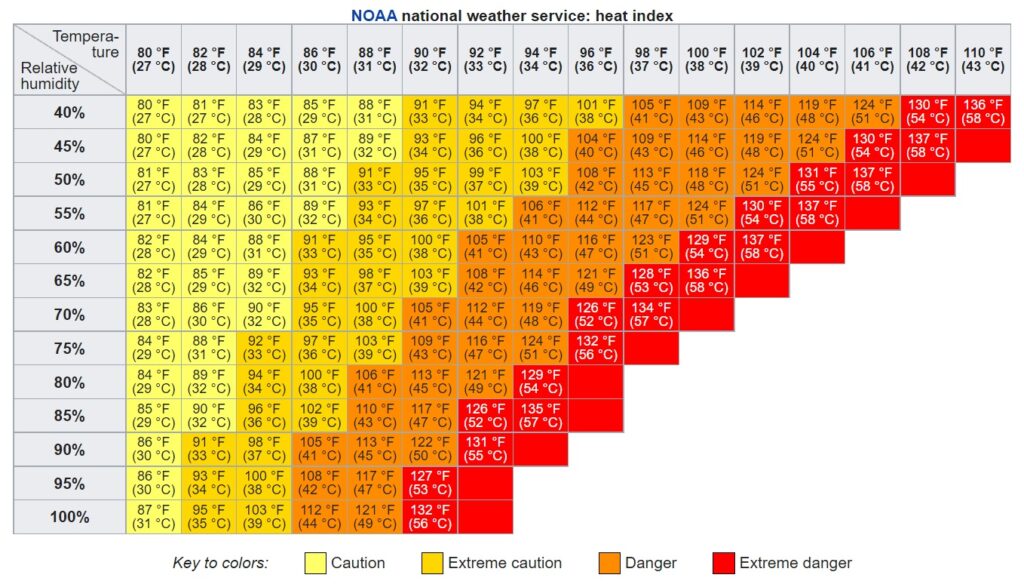
On this chart if the actual temperature is 34ºC, as it has been most afternoon’s this week, and the relative humidity is 50%, you are hovering on the line between extreme caution and danger.
Temperature, humidity and dewpoint are words that get thrown around a lot when forecasters talk about the weather.
These use of these terms complicate the simple question of how you should dress for the day.
Temperature is easy to define. “What’s the temperature?” – Look at a thermometer.
Preferably a thermometer made for the purpose and taking the reading at the international standard height of 1.2 to 1.8 meters above ground.
My air temperature thermometer is 1.5 meters above ground, in the shade.
The reading will not be altered by changes in the humidity and dew point of the air surrounding the device.
The thermometer is just measuring the temperature of the surrounding air.
However, changes in the humidity and dewpoint can make it feel hotter than it is, but the temperature itself is a simple, actual number based on how much heat is in the air at the moment you look at the scale.
Although the temperature is the key factor which does affects both of the other two data points.
Humidity and dewpoint
The Relative Humidity is a measurement of how much water vapor is in the air, when compared to how much the air can actually hold.
This number is displayed and referred to as a percentage.
100% humidity means that the air is saturated with moisture.
In reality when the temperature, humidity and dew point coincide we get fog. Water droplets (also known as rain) will create 100% humidity and can change the temperature, but will not affect the dew point.
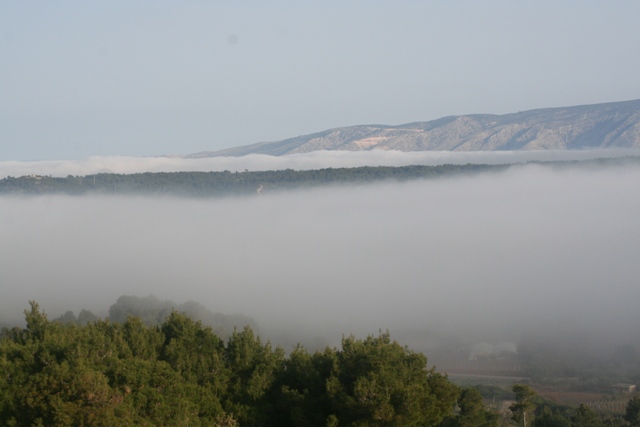
So in northern latitudes, cold, wet even freezing fog is a normal winter occurrence.
In hot climates, like rain forests or in Abu Dhabi, hot, sticky, wet summer fogs form.
0% humidity is only a theoretical possibility in nature. Even the Atacama Desert, the driest desert in the world, has an average RH of 70%
One of my favourite places is Tucson, Arizona where the Davis Monthan air base is located. The city is in the centre of a high plain, surrounded by mountains.
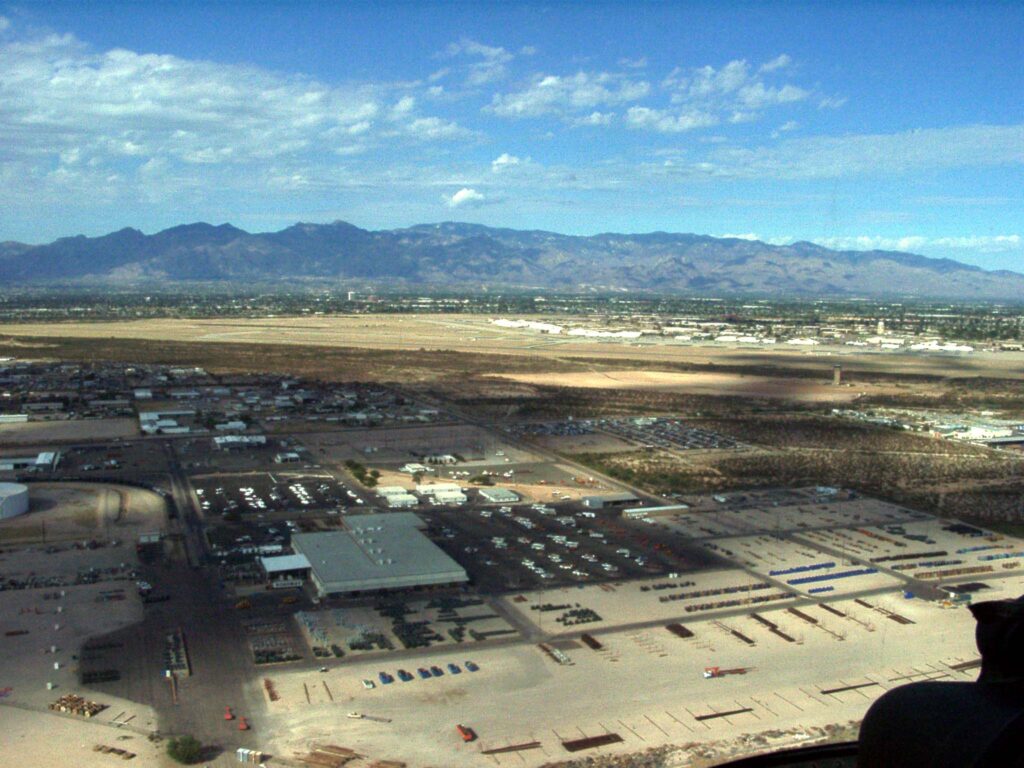
This is the high desert, complete with Saguaro Cactus and Road Runners. The Davis Monthan air base is where unused but air worthy aircraft are stored in the open air, before re-commissioning or decommissioning.

Because of the near perfect conditions, there is almost no corrosion, however there is still rain and an average RH of 37%.

The Relative Humidity, or RH, does not affect the temperature, but it does affect how we perceive it. The reverse is true though, because temperature does affect humidity.
Hot air can hold more water vapor than cold air, so this means that the relative humidity is on a sliding scale.
For example, 50% humidity on a sultry summer’s day would feel very uncomfortable, while 90% humidity in the winter can feel quite pleasant.
Because of this, many scientists and meteorologists feel that talking about humidity is confusing and prefer to give the dewpoint instead.
Personally I find it the other way round. Most people have heard of and talk about “humidity”, but the “dew point” is little understood outside scientific circles and is not a topic of conversation.
Humidity and dewpoint are related, as both measure the amount of the water in the air.
The “Dewpoint” is defined as “the lowest temperature at which dew will form, based on how much water vapor is currently in the air”.
If the dewpoint is the same or higher than the current temperature, then dew (and cloud or fog) will occur. It uses the same scale of degrees that the temperature does: for example, if the dewpoint and temperature are both 10ºC at ground level, dew will form on the leaves of plants.
When the temperature at ground level is below 0ºC, the moisture condenses as a radiation frost.
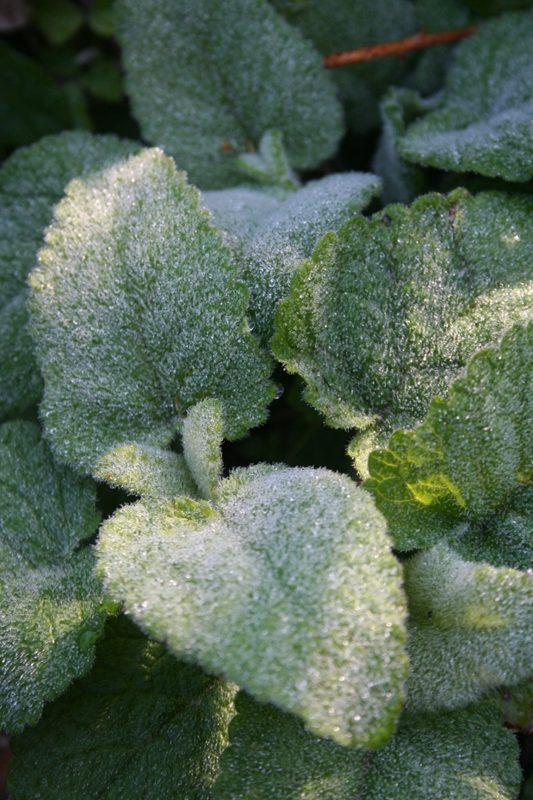
Some forecaster now prefer to use the dewpoint because it is a more concrete number than a relative humidity percentage.
I would disagree, because most ordinary people know and understand that 65% humidity in summer is sticky and uncomfortable. A dewpoint of 22ºC means little by itself.

So when you look at my very quick chart of the last ten days here in Dol, the low relative humidity is generally during the afternoon, with the high humidity being at night, making it uncomfortable to sleep.
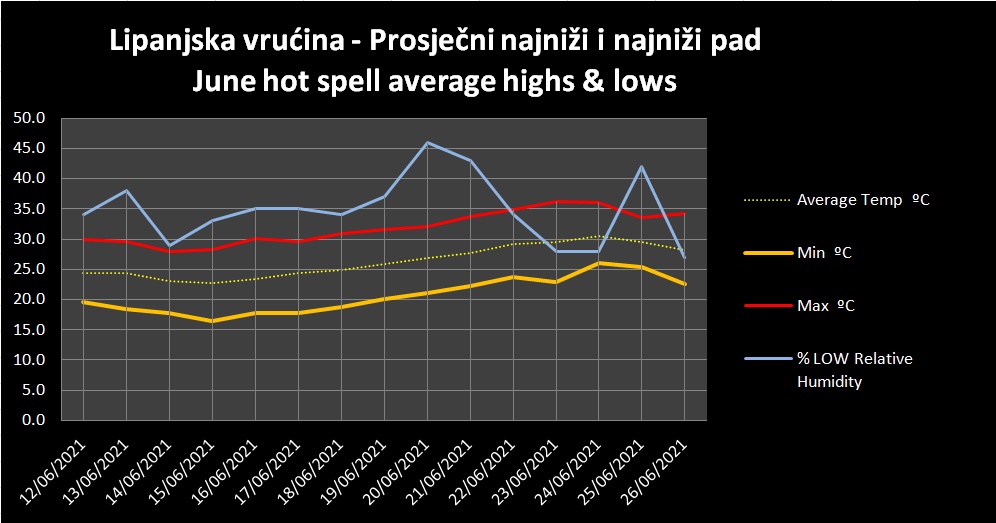
But when the low humidity is still high, as it was on Sunday the 20th, at 46%, combined with the temperature of 32ºC, it made for a very uncomfortable day.
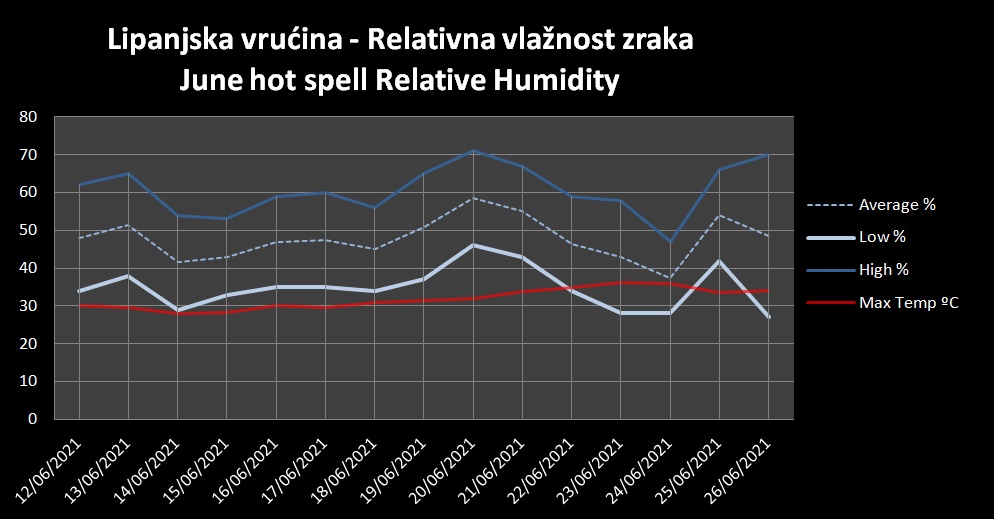
There are many very good on-line resources should you wish to delve deeper into this subject.
On my bookshelf of flying books and manuals, I have one volume just devoted to Temperature, RH and Dew Point.
When you get the so called “Five highs” together (temperature, RH, density altitude, aircraft weight), helicopter pilots really have to be extra careful.
This is because they might be unable to safely take off.

Dirty, dusty work
Bright and early on Monday I was in the cottage pantry with a medium size breaking hammer to start work on the walls.
With the warm temperatures, this was really not the week to have started this kind of physical work!
I was debating where to apply the first blows with the wide blade when I saw a crack in the plaster in one corner. Inserting the tip of the blade and applying power, a chunk of old lime plaster fell away to the floor with a thud.
Corners always seem like good places to begin anything, because you can always work outwards from a corner.
Where the plaster wall, which could at best be described as “rough”, was attached to a stone behind, it came away in a sheet.
As the piece hit the floor it would shatter and a cloud of fine dust would appear.
Between the stones, the plaster had adhered better to the mortar joints of the stonework.
It still broke away easily under the pressure of the hammer blade, but in much smaller pieces and creating even more dust.
By lunch time I had removed most of the plaster from one wall. I was also soaked in perspiration.
However I needed not just a shower but also a change of clothes because of the fine white dust which had covered everything. I was using a mask and gloves but on Tuesday I added more PPE with a hat and safety glasses.
The fine powder has also wreaked havoc with my safety boots. The dust and fine grains have worked their way into every seam and joint.
After I finish, they will probably need to be replaced…

As we passed the Summer Solstice, the mid-day and afternoon temperatures are over 33ºC. By 8am it is already 28ºC or more.
So between not wanting to annoy neighbours with noisy power tools, even when they are being used indoors, and with the building moratorium, the effective working day is from 08:00 to 11:00.
After this hour of the day it is unpleasantly hot to be working in a confined space that has poor ventilation.
When it came to removing the remains of the plaster, I had my next problem. The wheel barrow wouldn’t fit through the very narrow doorway. The splay of the handles made it too wide.

By turning the barrow sideways, once the front was inside, I could get it in, to load it with the spoil. But reversing back out was not so easy.
I found a way by painting some road makings on the floor, which I could follow with the wheel. This made getting the barrow back outside again much less difficult.

Road marking paint is just another of those things I keep on the workshop shelves, just in case…
I have to admit that I have often stopped physical work at morning coffee time so have not achieved as much as I would have liked to have done!

Developing plans
It wasn’t until I looked in my “plans” file, that I realised how much I rely on three dimensional sketches.
For someone who has grown up with computers and programming since being at school and one who uses software all the time, using hand drawn sketches may seem strange.
I have a couple of (legal) professional software programmes, for example CorelDRAW, and the free Google Sketchup, both of which will allow you to draw A∅ size plans to an accuracy of 0.1 of a millimetre.
This is far more accurate than I can ever construct anything to. When I am building something, I generally try and work to an accuracy of +/- 2 mm.
With odd shaped buildings, walls which are anything but true, window and doorways that are more or less square – often much less than more, drawing a highly accurate plan is satisfying but not very useful.
The district surveyor when he was inspecting my marking out before the workshop was built last year, was surprised when I told him I had used a laser level.
Granted, lasers are not the kind of thing which you find on many workshop shelves. I told him that my building outline was accurate to 5 cm and probably less. Jure told me that he was only required to work to an accuracy of 50 cm.
He had the most modern satellite surveying equipment and the various studs he installed in the roads around my home means he can come back and re-measure at any time.
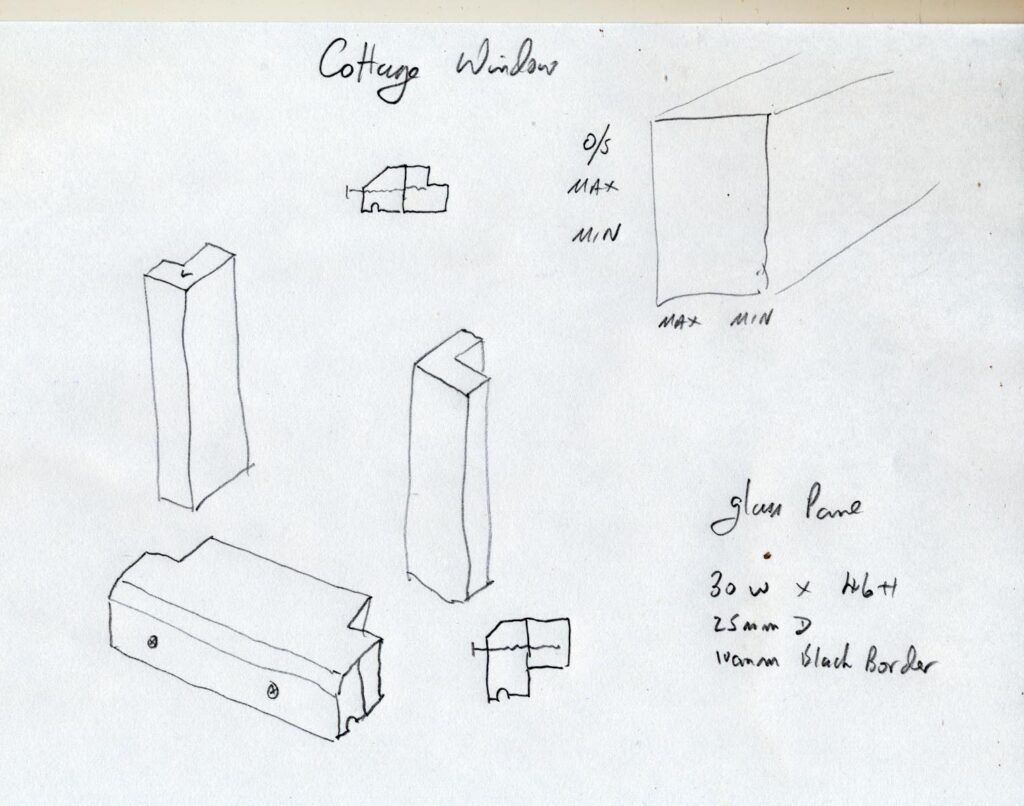
But because of the state of the buildings, so long as you are within a half meter of where you should be, officialdom would be happy!
There is a single, small north facing window void in the cottage.

This void had been covered with a mesh insect screen.
The mesh was framed in wood and has two hinges where there once must have been some kind of door. This door covering, to keep out the cold no doubt, has long since gone.
I will be putting new double glazed window and door in the side of the cottage, but I need to build a window to cover this opening.
This small window opening is made of dressed stone, so it is a little uneven.
With dimensions of just 46 cm x 30 cm wide, it is probably only going to be useful for ventilation. Being north facing, the level of light is constant during the year, but not exactly great.
My first job was to sketch a frame to fit around the outside of the window. Initially I was thinking of a permanently closed window, but then realised that although small, it does act as a good ventilator.
I already have the sealed double glazed unit, so my second thought is to build an opening window, starting with the unit, then the frame around it. This is counter intuitive, but when you already have the glass, it will make the rest of the project relatively easy.
A “top hung” sash would be the easiest, but with the prevailing wind, I’m also thinking about a side casement opening, so that when open, it will act as a scoop to direct airflow into the downstairs room.
My plans are still undergoing development, so watch this space!
More fire remains
I wrote a couple of weeks ago in my blog about the day that Dol burned.
This old cottage still bears the scars of that day too. Although it was not burnt to the ground, as many others in the villages were, the fire damage is still apparent.
The roof was made of the original thick paving stones, held up by stout tree trunks.
Stone slabs are heavy at the best of times and a roof of stone is especially so.

The roof had ceased to be waterproof and my laying plastic sheeting on top was about as effective as a piece of waterproof Elastoplast when you are water-skiing.
From the inside of the loft, there was an awful lot of daylight shining through between the stones. But in addition, the timbers and the inside of the stones showed soot marks and carbonisation, all the signs of a significant fire.
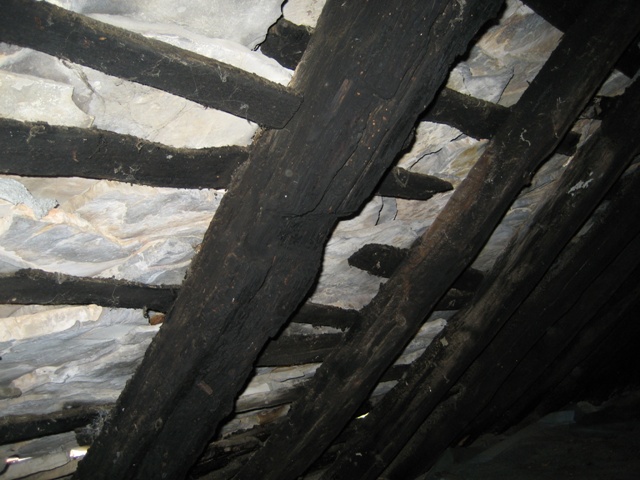
The loft floor was much newer, suggesting that the original ceiling/floor had burned away. This floor has now been completely replaced.
As I started to peel back the plaster from the cottage walls, I found that there were two very distict layers.
On top there was a thin screed which had been painted over with pink emulsion paint. This plaster layer had detached in many places from the layer underneath and just fell away.
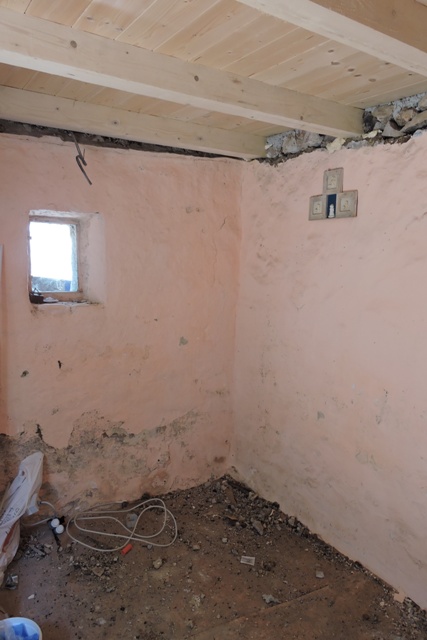
The older, main plaster layer, which was generally still attached to the wall behind was thicker and of a different material. It was black or dark brown.
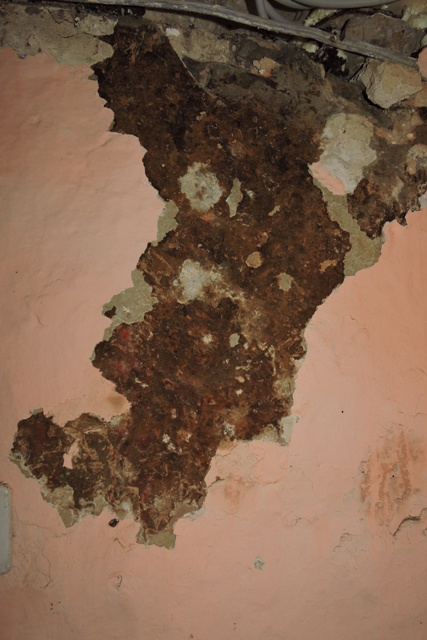
Wiping your finger along it brought carbon off onto your finger and there was in places even the faint smell of smoke.
I need to excavate the utility room walls in the other half of the building to confirm my suspicion that this is also the result of the 1943 fire.
The other possibility is that this was once a “smoke room”.
The smoking of meat and fish to preserve them is still practiced today in many places on the island, including by my neighbours.
It’s difficult to accept that electricity and running water only came to the village in the 1980’s. So before then, there were no refridgerators or deep freezers.
Every home would have a pig or two, goats, chickens, maybe ducks and of course their donkey or ass. A pig would be butchered each autumn and the meat smoked to preserve it for later use, over the winter.
So each home would have had somewhere that they could hang meat and gently smoke it over several days.
Whilst smoke would indeed colour walls and leave a smell behind, smoke alone is not going to create the burnt areas of the roof timbers.

With so few of the old people from that era still here, and none of the former residents of my home being here to ask, I will struggle to establish exactly what happened in 1943.
It is one of the sad things that there are no photographs of my home, from any of the decades before I bought it.
Unlike my parents and grandparent’s homes in the UK, where I have our family albums with hundreds of images, dating from the turn of the 19th century onwards, no records of Dol from that time seem to exist.
Feeling the heat
Until you have lived in a hot country, you cannot really appreciate just how debilitating the combination of heat and high humidity can be.
In Abu Dhabi everywhere, even outside, was “air conditioned”. And yes you can get outdoor air conditioning units which project minute ice crystals with a large fan, so that the body’s natural cooling system can operate when the cold fragments land on your skin.

Here in Dol, I do not have any mechanical air conditioning. Whereas the temperature in Dol seldom exceeds 36ºC, unlike Abu Dhabi where in summer it is often 49ºC.
In Abu Dhabi it is only because of the comprehensive air conditioning, that makes the place bearable in summer!
I use the differential pressure on different sides of buildings instead of having A/C.
With windows opposite each other, protected by fine insect mesh, I can have a cooling air flow through my buildings, both by day and by night.
All houses have window and often door shutters. By varying the louvre opening, air movement can be controlled.
At the same time, when doors and windows are closed and shuttered, you know not to disturb the occupants.
In a society where doors are generally open when people are at home, a closed door is an efficient signal to repel visitors.
Between the end of May and the start of September, most work ceases between 13:00 and 17:00.
In most Mediterranean countries a siesta is taken, often around 14:00. You know when it is siesta time because silence falls and doors are closed.
Writing this paragraph in my study, after my siesta, with the windows and doors open and just a light air movement cooling the 32ºC inside air temperature, it is silent outside.
Silence that is, apart from the background striations of the Cicadas and a Blackbird chortling away in a nearby tree. Another blackbird answers from the other side of my home.
It’s like listening in stereo. The swallows have stopped flying, presumably because the flies have stopped too.
When the air is hot, whether you are in a helicopter or you are an insect, you need to use a lot more energy to fly because the air is less dense.
There is no vehicle noise. In fact I am now really aware of the noise I am making by tapping on my computer keyboard. Suddenly it sounds really loud. I wonder if the neighbours can hear me….?
I can only find three felines. Tigger is flat out on the clean washing pile.
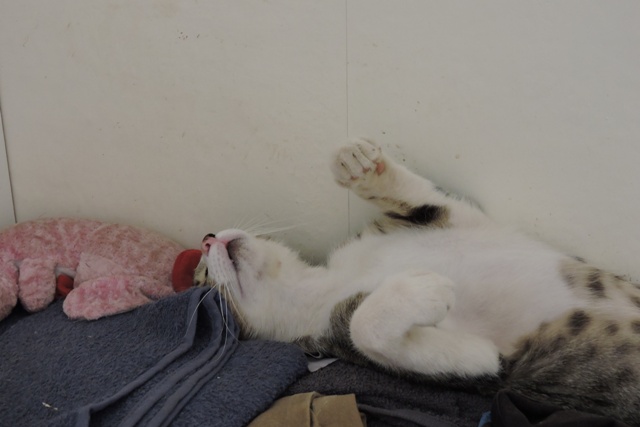
Sensible boy – I mean who would go to sleep in the dirty washing basket?
A cats underside is its most vulnerable part and hence it always is protective of its stomach area. When they are flat out, paws in the air, it means they feel absolutely safe and comfortable.
Argen and Pongo are asleep on the cool concrete under the patio. I have no idea where the others are, but they will have found somewhere similarly comfortable. They will all appear in about an hour for some tea.
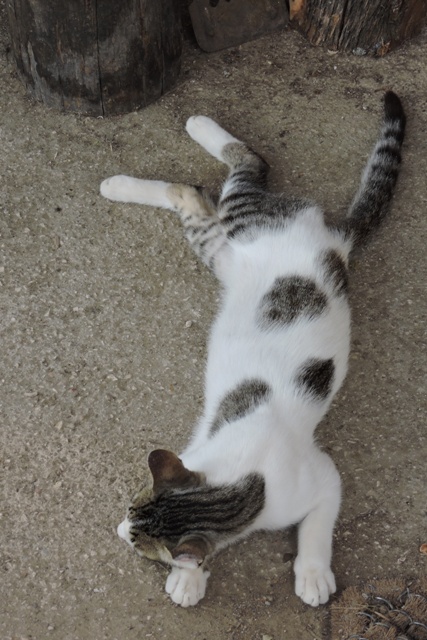
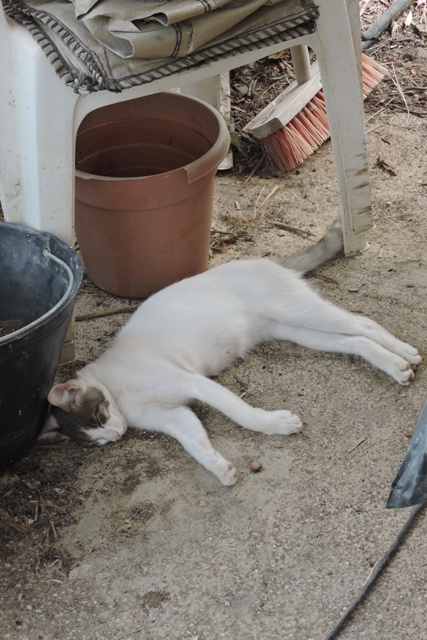
Siestas (for humans) should be short duration, little more than an hour long, so that they do not upset your night time sleep cycle.
After I have had my fifty to seventy minutes, I awake feeling refreshed and ready to start work again, even though it is still well over 30ºC outside.
Taking a siesta is not laziness, it is an essential means for the mammal world to survive in the summer heat. NCG
Looking back – Week 25
This is the start of links to past issues of the blog.
2014/25 100 year old news
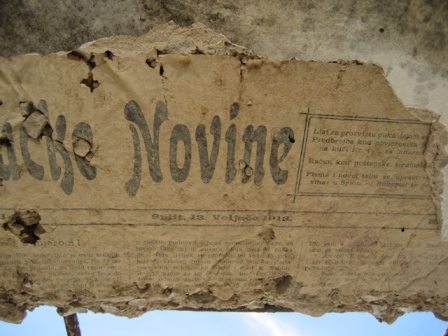
2016/25 A striking visitor at breakfast time

2018/25 Plants galore

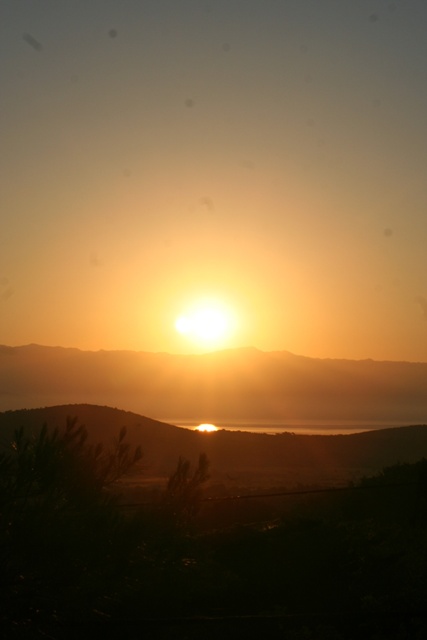
2020/25 Silent Sundays
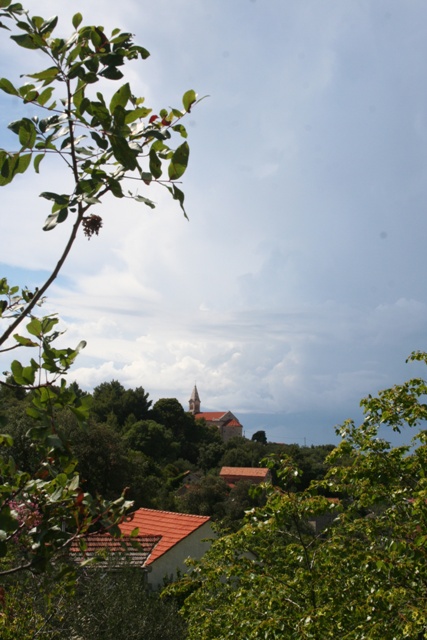
4 Responses
John Bsiley
Thanks Norman for taking the time to ex plain how you keep cool. I must admit I couldn’t live in those conditions. Far too hot for me. I am sure you are used to it and have adapted well. Once again a very interesting and informative read.
Alan Wheeler
Nice photos of Davis-Monthan AFB. I drive past there regularly going to COSTCO. Over the years they have added a fleet of C5A’s as well as a lot of C-140’s. High temperatures over the past two weeks have been in the 110 – 118 F. range. Cooled off to only 102 this week. Humidity 10 – 17%.
Interesting discovery of the fire damage to your building.
Michael
I experienced a marginal ‘5 High’ scenario as a passenger in a Gazelle in Sarajevo in the summer of 1996, which was a mite unnerving. Fortunately there was an experienced QHI in the second front seat to advise the corporal pilot. Summer and winter, Bosnia was a pretty hazardous place for flying.
Marcy
Norman, what a wonderful learning experience this week was. I really enjoyed the information on weather, humidity/dew point, and your charts. You have such a knack for teaching and compiling interesting information. In Colorado, it’s been raining for the past couple of days. Our highest temps have been 94F, but I’m in a place where the warm wind blows, and fans do the trick on most days. Nights are a different story – AC is required. Your property has an interesting past I bet. Have you checked either the library or local newspaper for any information? Just a thought. Hoping you have a cooler week ahead. Thank you again for including me in your posts.